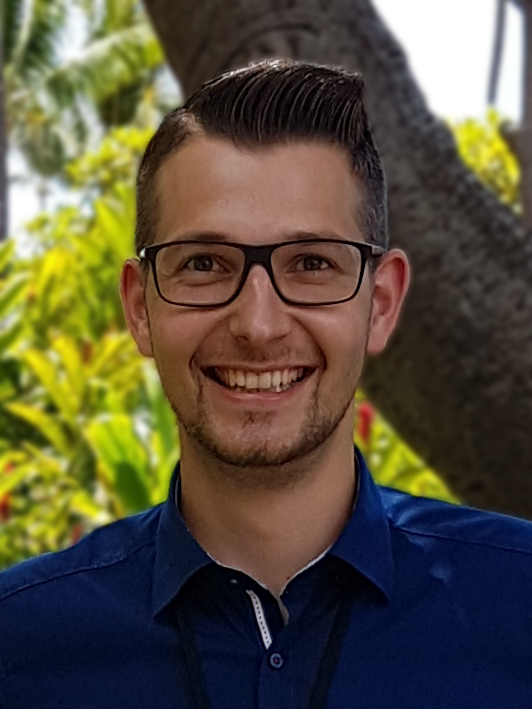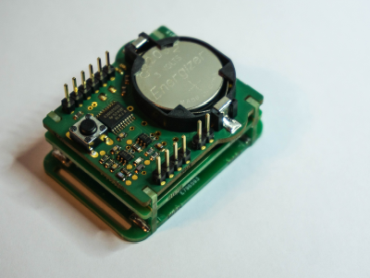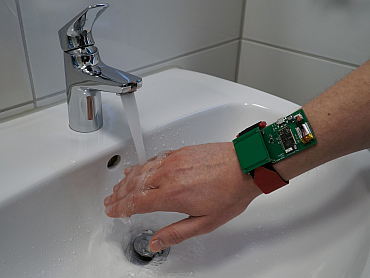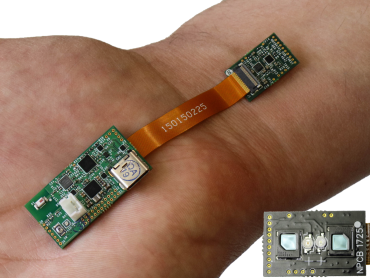Florian Wolling

Ubiquitous Computing, H-A 8106
Department of Electrical Engineering
and Computer Science
University of Siegen
Hölderlinstr. 3
57076 Siegen
Office: H-A | 8106
Office hours: open door policy
ubiquitous computing, wearable sensing systems, digital signal processing, photoplethysmography, wireless body-area networks, intra-body communication, body-coupled communication
- Since 2023, Vienna University of Technology (TU Wien), AT: Project/University Assistent of the research unit for Artifact-based Computing and User Research (link).
- 2016-2022, Universty of Siegen, DE: PhD Student and Research Associate of the Ubiquitous Computing Group, supervised by Prof. Kristof Van Laerhoven.
- 2019-2020, University of Oulu, FIN: DAAD short-term grant, Visiting Researcher at the Biomimetics and Intelligent Systems Group, supervised by Prof. Juha Röning. Collaboration with the Ubiquitous Computing group of Prof. Denzil Ferreira.
- 2013-2016, University of Freiburg, DE: (M.Sc.) Embedded Systems Engineering, Master's thesis: "Body-Coupled Communication in Intra-Body Sensor Networks", supervised by Philipp M. Scholl.
- 2014-2015, Reykjavík University, IS: Mechanical and Electrical Engineering, Erasmus+ grant of the DAAD.
- 2009-2013, University of Freiburg, DE: (B.Sc.) Embedded Systems Engineering, Bachelor's thesis: "Control and Measurement Data Analysis for the Laser Localization System GaLocate", supervised by Jan Kokert.
- 2017-2021, Ubiquitous Systems (UbiSys), lab course.
- 2020-2021, Data Science (UbiDS), seminar.
- 2017-2019, Ubiquitous Computing (UbiComp), tutorial.
- 2019, Recent Advances in Machine Learning (RAM), lecture of ZESS (center for sensor systems).
- 2018-2019, Embedded World, excursion to the international trade fair in Nuremberg.
OpenIBC: Open-Source Wake-Up Receiver for Capacitive Intra-Body Communication, . In 19th International Conference on Embedded Wireless Systems and Networks (EWSN 2022), Association for Computing Machinery (ACM), 2022.[abstractIntra-Body Communication (IBC) uses the human body as a part of the physical transmission channel for a more efficient and secure on-body communication. Since its introduction in 1995, it has evolved into an alternative to traditional wired and wireless techniques, and was eventually included as human body communication (HBC) in the IEEE 802.15.6 standard for wireless body area networks (WBAN). In contrast to the ubiquitous radio-frequency identification (RFID) and near-field communication (NFC), IBC has, however, not reached the market yet, and possible applications remain underinvestigated. We present the OpenIBC project and a first open-source IBC receiver that is based on a repurposed off-the-shelf low-power RFID wake-up receiver front-end. In the evaluation, the prototype achieved a data rate of 4096 bit/s with a packet error rate of 320.0E-6 at a low power of 7.4 µW in listening mode and 8.4 µW when receiving data. The design files and software are made available to encourage researchers to replicate and improve on our work, and to explore potential applications that benefit from IBC.][pdf][scholar][bibtex]
IBSync: Intra-body synchronization and implicit contextualization of wearable devices using artificial ECG landmarks, . Frontiers in Computer Science,4, 2022.[pdf][scholar][bibtex]
WetTouch: Touching Ground in the Wearable Detection of Hand-Washing Using Capacitive Sensing, . In WristSense 2022: Workshop on Sensing Systems and Applications Using Wrist Worn Smart Devices., Institute of Electrical and Electronics Engineers (IEEE), March,2022.[abstract][pdf][scholar][bibtex][honorable mention award]
Optimal Preprocessing of Raw Signals from Reflective Mode Photoplethysmography in Wearable Devices, . In 2021 43rd Annual International Conference of the IEEE Engineering in Medicine Biology Society (EMBC), 2021.[abstractThe optical measurement principle photoplethysmography has emerged in today’s wearable devices as the standard to monitor the wearer’s heart rate in everyday life. This cost-effective and easy-to-integrate technique has transformed from the original transmission mode pulse oximetry for clinical settings to the reflective mode of modern ambulatory, wrist-worn devices. Numerous proposed algorithms aim at the efficient heart rate measurement and accurate detection of the consecutive pulses for the derivation of secondary features from the heart rate variability. Most, however, have been evaluated either on own, closed recordings or on public datasets that often stem from clinical pulse oximeters in transmission instead of wearables’ reflective mode. Signals tend furthermore to be preprocessed with filters, which are rarely documented and unintentionally fitted to the available and applied signals. We investigate the influence of preprocessing on the peak positions and present the benchmark of two cutting-edge pulse detection algorithms on actual raw measurements from reflective mode photoplethysmography. Based on 21806 pulse labels, our evaluation shows that the most suitable but still universal filter passband is located at 0.5 to 15.0Hz since it preserves the required harmonics to shape the peak positions.][pdf][scholar][bibtex]
IBSync: Intra-body Synchronization of Wearable Devices Using Artificial ECG Landmarks, . In Proceedings of the 2021 International Symposium on Wearable Computers, ISWC 2021, September 21-26, 2021, ACM, 2021.[abstractThe synchronization of wearable devices in distributed, multi-device systems is a persistent challenge. Particularly machine learning approaches suffer from the devices’ inaccurate clock sources and unmatched time. While the online synchronization based on radio transmission is energy-intensive, offline approaches originated in activity recognition suffer from inaccurate motion patterns. In recent years, intra-body communication emerged as a promising technique that uses the human body as a limited and hence more efficient medium. Due to the absence of commercial platforms, applications are rare and underinvestigated. To boost their development and to enable the precise synchronization, we introduce IBSync and propose to repurpose the ECG sensor in commercial wearable devices to detect artificial signals induced into the skin. The shorttime Fourier transform and Pearson’s normalized cross-correlation are used to detect, precisely locate, and assign synchronization landmarks within the measurements. Based on a total of 105 min of recordings, we evaluated the concept and demonstrate its general feasibility with a promising accuracy of 0.203 ± 1.633 samples (1.587 ± 12.755 ms) in typical proximity to the transmitter. ][pdf][scholar][bibtex]
Introducing MILM: A Hybrid Minimal-Intrusive Load Monitoring Approach: Poster, . In Proceedings of the Twelfth ACM International Conference on Future Energy Systems, Association for Computing Machinery, 2021.[abstractThe shift towards an advanced electricity metering infrastructure has gained traction because of several smart meter roll-outs. This accelerated research in Non-Intrusive Load Monitoring techniques. These techniques highly benefit from the temporal resolution improvements achieved by smart meters. Nevertheless, industrial adoption is low, not least because the achieved disaggregation performance is rather poor for unsupervised approaches. This work sketches a way to utilize intrusive sensors in combination with a standard NILM system to enhance training and maximize overall system's performance while minimizing the number of required intrusive sensors.][pdf][scholar]
PulSync: The Heart Rate Variability as a Unique Fingerprint for the Alignment of Sensor Data Across Multiple Wearable Devices, . In PerHealth 2021: 5th IEEE PerCom Workshop on Pervasive Health Technologies (PerHealth 2021), Institute of Electrical and Electronics Engineers (IEEE), March,2021.[abstractMost off-the-shelf wearable devices do not provide reliable synchronization interfaces, causing multi-device sensing and machine learning approaches, e.g. for activity recognition, still to suffer from inaccurate clock sources and unmatched time. Instead of using active online synchronization techniques, such as those based on bidirectional wireless communication, we propose in this work to use the human heartbeat as a reference signal that is continuously and ubiquitously available throughout the entire body surface. We introduce PulSync, a novel approach that enables the alignment of sensor data across multiple devices utilizing the unique fingerprint-like character of the heart rate variability interval function. In an evaluation on a dataset from 25 subjects, we demonstrate the reliable alignment of independent ECG recordings with a mean accuracy of −0.71 ± 3.44 samples, respectively −2.86 ± 11.43 ms at 250 Hz sampling rate.][pdf][scholar][bibtex]
Smartphone-Based Monitoring of Parkinson Disease: Quasi-Experimental Study to Quantify Hand Tremor Severity and Medication Effectiveness, . JMIR Mhealth Uhealth, 8(11): e21543, Nov,2020.[abstractBackground: Hand tremor typically has a negative impact on a person's ability to complete many common daily activities. Previous research has investigated how to quantify hand tremor with smartphones and wearable sensors, mainly under controlled data collection conditions. Solutions for daily real-life settings remain largely underexplored. Objective: Our objective was to monitor and assess hand tremor severity in patients with Parkinson disease (PD), and to better understand the effects of PD medications in a naturalistic environment. Methods: Using the Welch method, we generated periodograms of accelerometer data and computed signal features to compare patients with varying degrees of PD symptoms. Results: We introduced and empirically evaluated the tremor intensity parameter (TIP), an accelerometer-based metric to quantify hand tremor severity in PD using smartphones. There was a statistically significant correlation between the TIP and self-assessed Unified Parkinson Disease Rating Scale (UPDRS) II tremor scores (Kendall rank correlation test: z=30.521, P<.001, $\tau$=0.5367379; n=11). An analysis of the ``before'' and ``after'' medication intake conditions identified a significant difference in accelerometer signal characteristics among participants with different levels of rigidity and bradykinesia (Wilcoxon rank sum test, P<.05). Conclusions: Our work demonstrates the potential use of smartphone inertial sensors as a systematic symptom severity assessment mechanism to monitor PD symptoms and to assess medication effectiveness remotely. Our smartphone-based monitoring app may also be relevant for other conditions where hand tremor is a prevalent symptom. ][pdf][scholar][bibtex]
The Quest for Raw Signals: A Quality Review of Publicly Available Photoplethysmography Datasets, . In In DATA'20: Proceedings of the 3rd Workshop on Data Acquisition To Analysis, DATA 2020, Virtual Event, Japan, November 2020, ACM, 2020.[abstractPhotoplethysmography is an optical measurement principle which is present in most modern wearable devices such as fitness trackers and smartwatches. As the analysis of physiological signals requires reliable but energy-efficient algorithms, suitable datasets are essential for their development, evaluation, and benchmark. A broad variety of clinical datasets is available with recordings from medical pulse oximeters which traditionally apply transmission mode photoplethysmography at the fingertip or earlobe. However, only few publicly available datasets utilize recent reflective mode sensors which are typically worn at the wrist and whose signals show different characteristics. Moreover, the recordings are often advertised as raw, but then turn out to be preprocessed and filtered while the applied parameters are not stated. In this way, the heart rate and its variability can be extracted, but interesting secondary information from the non-stationary signal is often lost. Consequently, the test of novel signal processing approaches for wearable devices usually implies the gathering of own or the use of inappropriate data. In this paper, we present a multi-varied method to analyze the suitability and applicability of presumably raw photoplethysmography signals. We present an analytical tool which applies 7 decision metrics to characterize 10 publicly available datasets with a focus on less or ideally unfiltered, raw signals. Besides the review, we finally provide a guideline for future datasets, to suit to and to be applicable in digital signal processing, to support the development and evaluation of algorithms for resource-limited wearable devices.][pdf][scholar][bibtex]
Unity in Diversity: Sampling Strategies in Wearable Photoplethysmography, . IEEE Pervasive Computing, 18(3): 63 -- 69, 2019.[abstractPhotoplethysmography optically measures the pulsating blood volume flow in the human skin so that primary vital signs such as the heart rate can be determined. Most known is this sensing principle from the mysterious illumination that can sometimes be seen at the back of fitness trackers and smartwatches. Since powering these high-intensity light puts a large dent into a wearable's energy budget, this paper delves into the sampling schemes and strategies used by current off-the-shelf wearables to save energy and yet obtain good readings. As it turns out, the devices are following very different approaches.][pdf][scholar][bibtex]
Fewer Samples for a Longer Life Span: Towards Long-Term Wearable PPG Analysis, . In Proceedings of the 5th International Workshop on Sensor-based Activity Recognition and Interaction, ACM Press, 2018.[abstractPhotoplethysmography (PPG) sensors have become a prevalent feature included in current wearables, as the cost and sizeof current PPG modules have dropped significantly. Research in the analysis of PPG data has recently expanded beyond the fast and accurate characterization of heart rate, into the adaptive handling of artifacts within the signal and even the capturing of respiration rate. In this paper, we instead explore using state-of-the-art PPG sensor modules for long-term wearable deployment and the observation of trends over minutes, rather than seconds. By focusing specifically on lowering the sampling rate and via analysis of the spectrum of frequencies alone, our approach minimizes the costly illumination-based sensing and can be used to detect the dominant frequencies of heart rate and respiration rate, but also enables to infer on activity of the sympathetic nervous system. We show in two experiments that such detections and measurements can still be achieved at low sampling rates down to 10 Hz, within a power-efficient platform. This approach enables miniature sensor designs that monitor average heart rate, respiration rate, and sympathetic nerve activity over longer stretches of time.][pdf][scholar][bibtex]
Combining Capacitive Coupling with Conductive Clothes: Towards Resource-Efficient Wearable Communication, . In Proceedings of the 2017 ACM International Symposium on Wearable Computers, ISWC 2017, Maui, Hawaii, September 11-15, 2017, ACM, 2017.[abstractTraditional intra-body communication approaches mostly rely on either fixed cable joints embedded in clothing, or on wireless radio transmission that tends to reach beyond the body. Situated between these approaches is body-coupled communication, a promising yet less-explored method that transmits information across the user's skin. We propose a novel body-coupled communication approach that simplifies the physical layer of data transmission via capacitive coupling between wearable systems with conductive fabrics: This layer provides a stable reference potential for the feedback path in proximity to the attached wearables on the human body, to cancel the erratic dependency on the environmental ground, and to increase the communications' reliability. Evaluation of our prototype shows significant increases in signal quality, due to reduced attenuation and noise. Requirements on hardware and, subsequently, energy consumption, cost, and implementation effort are reduced as well.][pdf][scholar][bibtex]
- March 2022, WristSense'22 (IEEE PerCom), Honorable Mention Award, virtual: "WetTouch: Touching Ground in the Wearable Detection of Hand-Washing Using Capacitive Sensing" (YouTube).
- September 2021, ISWC'21 (ACM UbiComp/ISWC), Honorable Mention, virtual: "IBSync: Intra-body Synchronization of Wearable Devices Using Artificial ECG Landmarks" (YouTube).
- May 2021, International Day of Light (IDL), UNESCO IBSP, MENELAOS, virtual: "On the Pulse in Light: Optics in Wearable Devices".
- March 2021, PerHealth'21 (IEEE PerCom), virtual: "PulSync: The Heart Rate Variability as a Unique Fingerprint for the Alignment of Sensor Data Across Multiple Wearable Devices" - teaser (YouTube) and full presentation (YouTube).
- November 2020, DATA'20 (ACM SenSys/BuildSys), virtual: "The Quest for Raw Signals: A Quality Review of Publicly Available Photoplethysmography Datasets" (YouTube).
- September 2018, iWOAR'18, Berlin, Germany: "Fewer Samples for a Longer Life Span: Towards Long-Term Wearable PPG Analysis".
- September 2018, Dagstuhl Seminar on Body-Centric Computing (17392), Dagstuhl, Germany: "Resource-Efficient Intra-Body Communication".
- September 2017, ISWC'17, Maui, Hawaii, USA: "Combining Capacitive Coupling with Conductive Clothes: Towards Resource-Efficient Wearable Communication".
- March 2022, WristSense'22 (IEEE PerCom): Honorable Mention Award.




